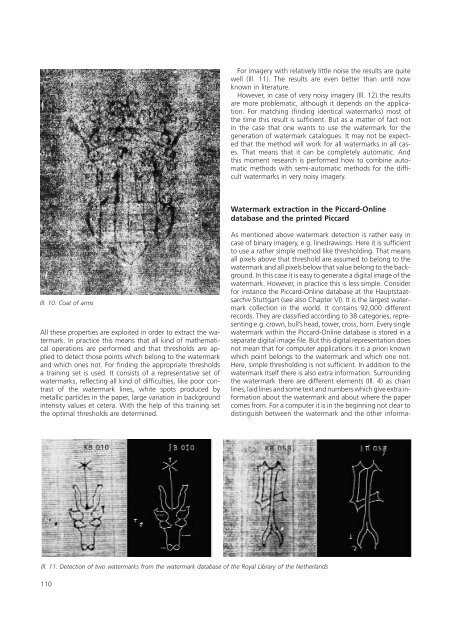Bull's Head and Mermaid - The Bernstein Project - Österreichische ...
Bull's Head and Mermaid - The Bernstein Project - Österreichische ...
Bull's Head and Mermaid - The Bernstein Project - Österreichische ...
You also want an ePaper? Increase the reach of your titles
YUMPU automatically turns print PDFs into web optimized ePapers that Google loves.
Ill. 10: Coat of arms<br />
All these properties are exploited in order to extract the watermark.<br />
In practice this means that all kind of mathematical<br />
operations are performed <strong>and</strong> that thresholds are applied<br />
to detect those points which belong to the watermark<br />
<strong>and</strong> which ones not. For finding the appropriate thresholds<br />
a training set is used. It consists of a representative set of<br />
watermarks, reflecting all kind of difficulties, like poor contrast<br />
of the watermark lines, white spots produced by<br />
metallic particles in the paper, large variation in background<br />
intensity values et cetera. With the help of this training set<br />
the optimal thresholds are determined.<br />
110<br />
For imagery with relatively little noise the results are quite<br />
well (Ill. 11). <strong>The</strong> results are even better than until now<br />
known in literature.<br />
However, in case of very noisy imagery (Ill. 12) the results<br />
are more problematic, although it depends on the application.<br />
For matching (finding identical watermarks) most of<br />
the time this result is sufficient. But as a matter of fact not<br />
in the case that one wants to use the watermark for the<br />
generation of watermark catalogues. It may not be expected<br />
that the method will work for all watermarks in all cases.<br />
That means that it can be completely automatic. And<br />
this moment research is performed how to combine automatic<br />
methods with semi-automatic methods for the difficult<br />
watermarks in very noisy imagery.<br />
Watermark extraction in the Piccard-Online<br />
database <strong>and</strong> the printed Piccard<br />
As mentioned above watermark detection is rather easy in<br />
case of binary imagery, e.g. linedrawings. Here it is sufficient<br />
to use a rather simple method like thresholding. That means<br />
all pixels above that threshold are assumed to belong to the<br />
watermark <strong>and</strong> all pixels below that value belong to the background.<br />
In this case it is easy to generate a digital image of the<br />
watermark. However, in practice this is less simple. Consider<br />
for instance the Piccard-Online database at the Hauptstaatsarchiv<br />
Stuttgart (see also Chapter VI). It is the largest watermark<br />
collection in the world. It contains 92,000 different<br />
records. <strong>The</strong>y are classified according to 38 categories, representing<br />
e.g. crown, bull’s head, tower, cross, horn. Every single<br />
watermark within the Piccard-Online database is stored in a<br />
separate digital image file. But this digital representation does<br />
not mean that for computer applications it is a priori known<br />
which point belongs to the watermark <strong>and</strong> which one not.<br />
Here, simple thresholding is not sufficient. In addition to the<br />
watermark itself there is also extra information. Surrounding<br />
the watermark there are different elements (Ill. 4) as chain<br />
lines, laid lines <strong>and</strong> some text <strong>and</strong> numbers which give extra information<br />
about the watermark <strong>and</strong> about where the paper<br />
comes from. For a computer it is in the beginning not clear to<br />
distinguish between the watermark <strong>and</strong> the other informa-<br />
Ill. 11: Detection of two watermarks from the watermark database of the Royal Library of the Netherl<strong>and</strong>s









